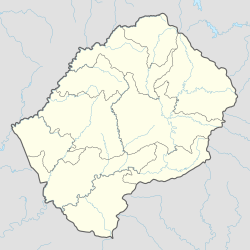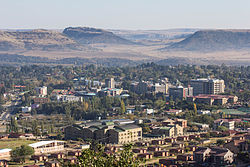Maseru
| Maseru | ||
|---|---|---|
|
|
||
| Coordinates | 29 ° 19 ′ S , 27 ° 29 ′ E | |
| Basic data | ||
| Country | Lesotho | |
| District | Maseru | |
| ISO 3166-2 | LS | |
| height | 1550 m | |
| Residents | 330,760 (2016) | |
| founding | 1869 | |
| Culture | ||
| Twin cities |
|
|
|
View of downtown from Parliament Hill
|
||
Maseru is the capital of Lesotho and has about 330,760 inhabitants (as of 2016).
geography
Maseru is located on the Caledon River ( Sesotho : Mohokare ) in western Lesotho and is the only major city in the country. It is about 1550 meters above sea level and is the capital of the district of the same name . The Caledon is the border river to South Africa .
history
Maseru was a small trading post at a ford of the Caledon on the border of Basutoland and the Orange Free State when it was made the capital in 1869 under the chief of the Basotho , Moshoeshoe I. Maseru denotes the Sesotho word for a certain type of sandstone that occurs in Maseru. From 1869 to 1871 and from 1884 to 1966 it was the capital of the British Protectorate , later crown colony , Basutoland, and for a long time only served the colonial rulers as a place of residence. In 1904 the first bank branch opened in Basutoland in Maseru, and in 1905 Maseru received a rail connection to the Orange Free State via the newly built Caledon Bridge. In 1933 some areas received Maserus power supply. In 1948 600 Europeans and 2000 Basotho lived there. However, since there were facilities such as the Basutoland Club , which were reserved only for whites, protests took place, mainly at the initiative of the Pan-African Basutoland Congress Party (BCP). 1958 which was east of the center Roman Catholic Cathedral Cathedral of our Lady of Victories built (see also: Roman Catholicism in Lesotho ).
In 1966 Maseru became the capital of independent Lesotho. At that time, 15,000 people lived in the city. Since independence in 1966, many authorities and diplomatic missions have been established. However, the German embassy was closed in the 1990s for financial reasons.
In 1980 the urban area was expanded from 23 km² to 138 km². On December 9, 1982 around 100 soldiers of the South African Defense Force crossed the border to Lesotho in a commando operation with helicopters and shot 42 people in Maseru, including 30 South Africans who had lived there in exile, and twelve from Lesotho (see South African attack on Lesotho 1982 ).
In September 1988 Pope John Paul II visited the city. The climax of the celebration was the beatification of Father Joseph Gérard . He was a missionary and played a major role in the Christianization of the Basotho in the 19th century . Instead of the expected million believers, only about 10,000 people came to the papal mass in Maseru. Even today the specially built grand stand stands in the midst of poor settlements. Maseru has been the Roman Catholic bishopric since 1894 and the seat of the Archbishop of the Archdiocese of Maseru since 1977 .
During the political unrest in March 1991 numerous shops were destroyed; there were over 40 dead. In September 1998, large parts of the center of Maseru were looted and burned down. Above all, South African and Asian shopkeepers were harmed.
economy
As the capital, Maseru is also the country's economic center. The main highways of Lesotho converge here. The headquarters of all banks, wholesalers and retailers as well as hotels and restaurants operating in Lesotho are located in Maseru.
A notable company is Maluti Mountain Brewery , which produces several types of beer under a South African license. The Lesotho Flour Mills , a large mill, has a high turnover.
Candles and carpets are made in the city . Since around 2000, a company headed by Taiwanese businessmen has been producing jeans and denim fabrics mainly for the American market. The working conditions are often catastrophic.
traffic
Maseru is the center of public transport in the country. Numerous bus and shared taxi lines meet here. The main inner-city streets are the Kingsway , the main shopping street, and the Moshoeshoe Road, next to it the four-lane Mpilo Mpilo road south of the Kingsway. Maseru is also approached by rail from South Africa for freight transport (see Rail transport in Lesotho ).
The international airport Moshoeshoe I. International Airport is about 20 kilometers south of the city near the Main South , the arterial road going south. A local airport has only been used for military purposes and relief flights since the opening of Moshoeshoe I. International Airport.
Infrastructure
Maseru is a fairly modern city with numerous government offices, businesses, asphalt roads, supermarkets, schools, the Queen Elizabeth II Hospital , the largest church in Lesotho (the Cathedral of our Lady of Victories ) and the modern national stadium, which was built in the 1980s has been. Many large companies have their headquarters on Moshoeshoe Road . Also the palace of King Letsie III. as well as the parliament building and the ministries is in the center of the city.
Some areas of the National University of Lesotho (NUL; National University of Lesotho) are located in Maseru, such as the Faculty of Agricultural Sciences and the Institute for Adult Education (IEMS). The National Teacher Training College (NTTC) is also located in Maseru, as are numerous primary and secondary schools.
Sports
The city is home to the Setsoto Stadium, the country's national stadium, which was completely renovated from 2010-2011. The teams in the Lesotho Premier League include the Maseru-based teams Kick4Life FC , Lesotho Correctional Services FC , Lesotho Defense Force FC , Lesotho Mounted Police Service FC , Likhopo FC and Matlama FC .
Climate table
| Maseru | ||||||||||||||||||||||||||||||||||||||||||||||||
|---|---|---|---|---|---|---|---|---|---|---|---|---|---|---|---|---|---|---|---|---|---|---|---|---|---|---|---|---|---|---|---|---|---|---|---|---|---|---|---|---|---|---|---|---|---|---|---|---|
| Climate diagram | ||||||||||||||||||||||||||||||||||||||||||||||||
| ||||||||||||||||||||||||||||||||||||||||||||||||
|
Average monthly temperatures and rainfall for Maseru
Source: wetterkontor.de
|
|||||||||||||||||||||||||||||||||||||||||||||||||||||||||||||||||||||||||||||||||||||||||||||||||||||||||||||||||||||||||||||||||||||||||||||||||||||||||||||||||||||
sons and daughters of the town
- Thomas Thabane (* 1939), politician
- Makhaola Ndebele (* 1971), actor and theater director
- Masempe Theko (* 1987), swimmer
- Lerato Sechele (* 1994), triple jumper
- Lerotholi David Seeiso (* 2007), Crown Prince of Lesotho
See also
Web links
Individual evidence
- ↑ CIA Factbook: Population 2009
- ↑ Lesotho: Districts & Cities - Population Statistics, Maps, Charts, Weather and Web Information. Retrieved March 17, 2018 .
- ↑ a b c d e f Scott Rosenberg, Richard W. Weisfelder, Michelle Frisbie-Fulton: Historical Dictionary of Lesotho. Scarecrow Press, Lanham, Maryland / Oxford 2004, ISBN 978-0-8108-4871-9 , pp. 229-231.




